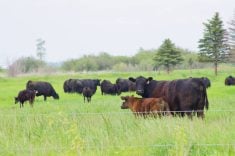At the start of the COVID-19 pandemic, there were many unknowns. Where did the virus come from? What are the main disease manifestations?
Certainly, many public health experts and veterinarians were also wondering: will it infect animals? Within a few months, we had some answers, including insight into the animal situation.
The virus can infect roughly 30 species including dogs, domestic cats, wild big cats (tigers, lions) and others, although it doesn’t tend to cause significant illness.
In addition to experimental infections in laboratory settings, animals have picked up infections from close contact with their infected caretakers. But the ability of the virus to spread in wildlife remained unknown.
Read Also

Canada told trade crisis solutions in its hands
Canadians and Canadian exporters need to accept that the old rules of trade are over, and open access to the U.S. market may also be over, says the chief financial correspondent for CTV News.
Early on, experimental infections were attempted in a number of captive wild animal species to determine which were highest at risk.
It seems the SARS-CoV-2 virus is capable of infecting a wide range of species, such as deer mice, skunks, raccoons, hamsters, European rabbits, fruit bats and notably, white-tailed deer. Deer in experimental studies did not experience significant illness.
Based on these results, a study of white-tailed deer was undertaken in New York, Illinois, Michigan and Pennsylvania. The detection of antibodies in approximately 40 percent of deer suggested that deer were being frequently exposed to the virus and were mounting an immune response.
Next, a group of researchers used a PCR test to detect the presence of viral DNA in more than 300 wild white-tailed deer in Ohio. Slightly more than one-third of deer tested positive for the virus. Deer from areas near cities, as well as male and heavier deer, were more likely to test positive.
This group, which published their results in the prestigious scientific journal Nature, then went a step further. The researchers were able to isolate viable virus twice, which supports the idea that deer are not just infected but also spread the virus.
Their work on genetic sequencing of 14 of the deer viruses provides further evidence that deer pick up the virus from people.
In this study, they identified six separate times where deer picked up the virus from people, based on genetic sequences and the variants that were circulating in the human population at that time in the area.
Why are deer picking up this infection? The answer is likely complex and nuanced. They have the appropriate biology, including virus receptors that allow infection to occur.
Deer thrive in urban and suburban landscapes. In these developed areas, deer may contact virus-contaminated materials such as human waste water, trash, backyard feeders and gardens.
Deer likely spread the virus through social nose touching. This is supported by the apparently higher infection rates in male deer, which tend to contact more deer and move over larger areas. Higher infections of CWD are also found among male deer.
Recent pre-print studies in Canada, which have not yet undergone peer review or publication in a scientific journal, supports that deer are susceptible to infection and could pass the virus to people.
In the first study, researchers sampled slightly more than 250 white-tailed deer during the last hunting season in Quebec, finding one percent infected and antibodies in roughly six percent.
Genetic sequences of the virus in deer were similar to those that were circulating in the nearby human populations at the same time.
In the second study, slightly less than 300 white-tailed deer were sampled during the hunting season in Ontario, with six percent testing positive.
The researchers compared the genetic sequences of these deer to those found in people. The deer virus had a unique signature and one human case of COVID appears to have been caused by the deer-type virus. This person had contact with deer and lived in the same area as where the positive deer cases occurred, further supporting transmission from deer to people.
We haven’t seen the last of the COVID-19 pandemic, especially since it is capable of jumping into deer and spreading.
This concerning feature may promote further mutations and allow the spread of variants from animals back into people. We know a great deal more in the third year than when we did at the beginning, but how the end of the pandemic plays out with local animal reservoirs remains to be seen.















